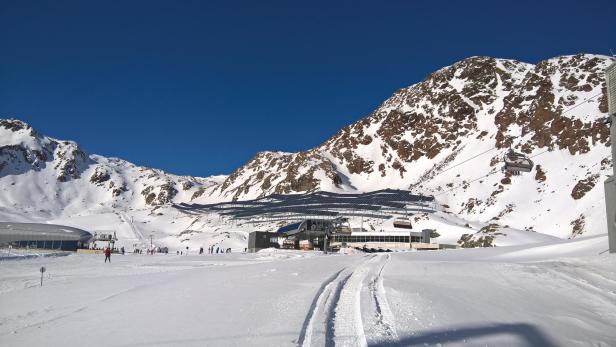The Pitztal Glacier has a PV system at 3000 m
© Florian Jamscheck/ehoch2
Barbara Wimmer
In our neighboring country Switzerland is a real hype all around photovoltaic systems flared up in the mountains, especially in high alpine regions. But does that make any sense at all, despite the higher costs, difficult transport conditions and greater environmental influences?
In fact, there are some advantages: Especially in the winter months, when we have to import electricity, better yields can be achieved with solar systems in higher regions. “Due to colder temperatures, which ensure that the modules are more efficient, and due to the higher number of hours of sunshine beyond fog and clouds, significantly more electricity can be generated,” explains Hubert Fechnerchairman of the Austrian technology platform photovoltaics, in conversation with the futurezone.
Not only the sunny altitude has a positive effect, but also that there is significantly less dust and dirt than in urban areas. Snow reflections also lead to an increase in yield, especially in winter.
Pioneer project from Austria
Am Pitztal Glacier in Tyrol Europe’s highest photovoltaic power plant has been in existence since 2015 with a maximum output of approx. 1,000kWp (Kilowattpeak). It got on around 3,000 meters altitude built. The PV system with an annual yield over 1,450,000 kWh (kilowatt hours)this is energy for 380 to 420 households per year, is considered a pioneer plant in alpine regions.
It is one of the “heart projects” of Florian Jamschek by the company ehoch2, which was responsible for the technical implementation of the project. According to Jamschek, the yield on the glacier per kilowatt of installed capacity is approx. 1.480 kWh (kilowatt hour). In the valley it would only be about 900 bus 1100 kWh – and that with a system that is already eight years old. “We currently have around 40 percent additional yield. Nowadays, you could still significantly increase yields with bifacial modules,” Jamschek explains to futurezone. Bifacial means that the module can be used on the front and on the back to generate electricity.
If the system is not on supports high enough, snow drifts could snow the system and damage the modules
© Florian Jamscheck/ehoch2
There are also challenges: snow
“Such systems are really useful because we can generate an insane amount of electricity,” says Jamschek. However, there are other challenges to this. “One problem that was definitely underestimated by other operators is the fact that PV systems can be snowed in and break down as a result,” explains the expert. Snow deposits and wind drifts can have an extremely negative impact here.
“We therefore carried out snow measurements on the Pitztal Glacier before the height of the construction was fixed. The deepest snow was six meters and that’s why we took the system with us 7.5 meters built very high. That paid off,” explains Jamschek. Also a avalanche protection has already proven itself, because 3 years ago an avalanche actually came down for the first time, which would have destroyed the system without protection, according to the expert. It was also quite difficult to transport the materials on site. Here you have to reckon with higher costs than in the valley.
Ski and hiking areas benefit from tourism
The Pitztal Glacier is also a skiing and hiking area that is used by tourists both in winter and in summer. “Thanks to the PV system a third of the energy of the ski area covered,” says Jamschek. This is used to operate lifts, for example, and to supply restaurants and other infrastructure with electricity. “It definitely pays off for ski resorts to accept the hardship and additional costs,” says Jamschek. In the meantime, due to the increased electricity prices, it is very economical to build PV systems in the mountains. In Tyrol are therefore “another 5 to 6 PV systems“ planned in ski resorts.
“If there are suitable locations in the Alpine region that have passed the necessary approval procedures, there is nothing to be said against PV systems in Alpine or high-Alpine locations,” explains the Tyrolean Energy Provincial Councilor Josef Geisler the future zone. “The selection of locations in high alpine terrain requires a great deal of sensitivity and good integration into the natural landscape. Above all, PV systems in areas that are already affected, such as ski areas, are to be endorsed. The development is also available here,” says Geisler.
The facility on the Pitztau Glacier is directly connected to the lift infrastructure and the restaurants. A third of the electricity requirement can be covered with it
© Florian Jamscheck/ehoch2
No explicit funding for alpine regions
However, these PV systems in the mountains are not explicitly funded in Austria. This is also confirmed by the Ministry of Climate Protection. In Switzerland, where there is now a solar boom in the mountains with huge systems, it’s different. “The Swiss are massively promoting alpine PV systems,” explains Fechner. However, there is also a “slightly different situation” than in Austria: While there is a good wind power scene in Austria and a lot of potential for further wind projects, things are looking bleak in Switzerland in this regard.
On 1,400 wind turbines in Austria come in switzerland hot 42. “The Swiss simply lack space and suitable wind locations, so they are under even more pressure than we are,” says Fechner. Fechner is also convinced that PV systems in the mountains make sense, especially in the vicinity of “standing hydroelectric power plants and facilities used by tourists”.
The system on the Pitztal Glacier, on the other hand, is a successful project. It is now to be expanded in the near future. “Plans will soon be submitted to the responsible authorities,” explains Jamschek.
Part 1 of this photovoltaic series “Everywhere we need photovoltaics to achieve our climate goals” can be found here. Tomorrow you will read part 3 of the series at futurezone.



